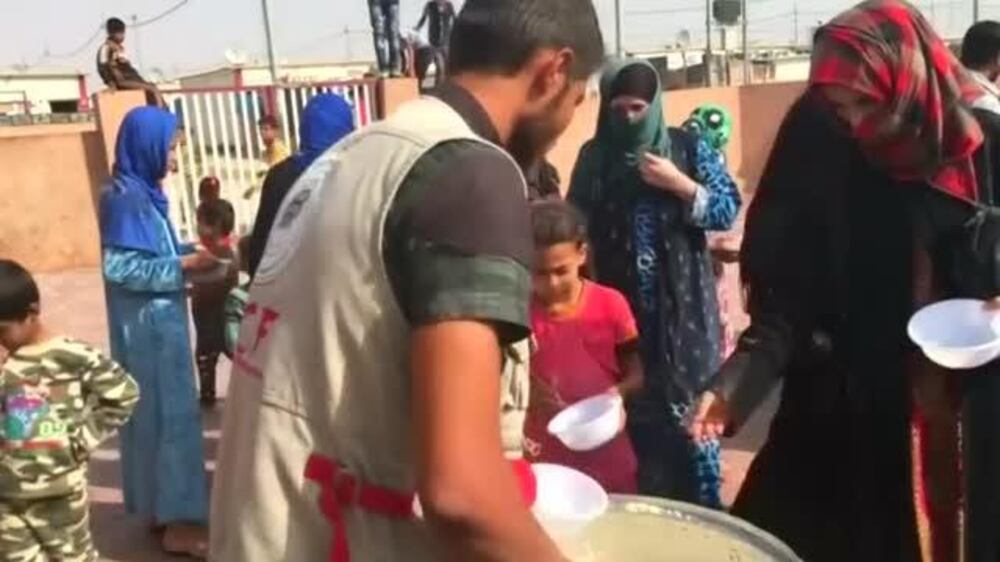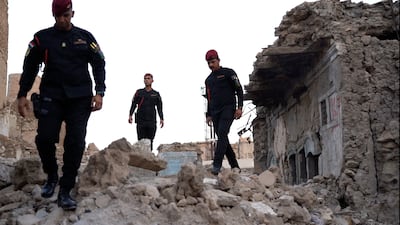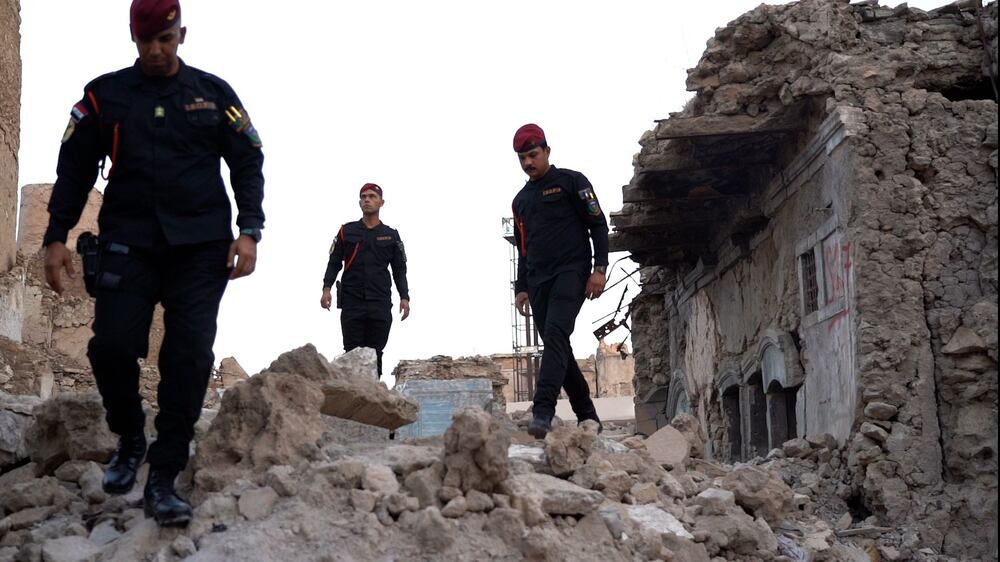Dressed in their distinctive black uniforms, fours soldiers of Iraq's Counter-Terrorism Services last week revisited the scenes of their bloody battles against ISIS in Mosul, the northern city the elite force played a key role in liberating five years ago.
The extremist militants put up a fierce resistance to hold on to Mosul, the first Iraqi city they seized after sweeping out of Syria in June 2014 and the last to remain under their control after a grinding campaign by government forces backed by a US-led international coalition.
“They were in big numbers here and used car bombs,” said Captain Hassan Ali Hassan, standing in the Aden neighbourhood of eastern Mosul where his unit began their battle in October 2016.
Accompanied by three of his CTS comrades, all now part of the force's Nineveh Regiment stationed at the Mosul Dam, the 30-year-old officer was guiding The National through the sites where they battled the militants in the city's eastern and western halves, divided by the Tigris that flows through its centre.
Captain Hassan recalled how they crossed Al Khosr River, a tributary of the Tigris, and managed to take over two houses in the neighbourhood.
“The biggest challenge was that the fighting and confrontations were among the houses.”
The homes were crammed with families and the militants would shoot at them from the roofs and run, he said.
“The families were in panic and their faces were full of fear, but when they saw us, joy and happiness returned to their faces," he said.
“They were living in terror and fear, as if they were prisoners and got released. Whenever we liberated a house, we heard ululations and laughter."
The middle-class neighbourhood still bears the scar of the battle, with most of the houses are still pockmarked with bullet holes.
Another soldier in the group, Samir Mohammed, played a video of the fighting on his phone, showing soldiers in full combat gear moving from house to house under heavy fire from the militants.
He recalled how some residents later came to them carrying the bodies of doctors that ISIS had killed a day earlier for refusing to treat the wounded militants.
A force for good
Fleeing Mosul under a cover of smoke - video

The battle for Mosul marked the final stages of a military campaign to retake the Iraqi territory seized by ISIS in the north and west of the country in 2014, as the army and federal police crumbled without putting up a fight.
After Mosul, ISIS seized the former dictator Saddam Hussein’s home town of Tikrit, north of Baghdad, and large parts of the western Anbar province. They even pursued Iraqi security forces to the edges of the Kirkuk province and south to the capital Baghdad.
For months after the ISIS onslaught and before the creation of the international coalition, the Counter-Terrorism Service, popularly known the Golden Division, and the Popular Mobilisation Forces, an umbrella group of Iraqi paramilitaries, were the only effective fighting forces against ISIS.
The US created the CTS shortly after it led the 2003 invasion that toppled Saddam, as a multi-ethnic and cross-sectarian national force, while the PMF was originally comprised of volunteers answering a call from Shiite spiritual leader Grand Ayatollah Ali Al Sistani to take up arms against ISIS, before Tehran-aligned militias and other Sunni fighters joined.
With its effective counter-terrorism training and advanced equipment and intelligence capabilities, the CTS took the lead in the battle for Mosul.
The PMF was restricted to the surrounding areas, as the government sought to allay the fears of religious and ethnic minorities after accusations of human rights violations by the group on other battlefronts.
Residents greeted Captain Hassan and his comrades as they visited the Aden neighbourhood, with children running alongside as they walked among the houses.
An old woman who came out of one of the houses recalled: “We were hiding under the stairs when they came and climbed up to the roof.
"We ran out of water, so I went out and told them: 'We have no water for the milk for babies, thirst is killing us’. Then one of the heroes brought four parcels of bottled water and put them inside.
“That day we baked bread and our stomachs were full."
“May god protect you," she told the soldiers."God willing, you will stay alive and save everyone's lives in an ordeal.”

Showdown in western Mosul
Three weeks after retaking eastern Mosul in late January 2017, the US-backed CTS troops advanced to the western side where the final and heaviest fighting took place in the Old City, a densely populated quarter with narrow, winding alleys.
“The fight here was the hardest, they used more car bombs and drones,” Captain Hassan said, standing amid the rubble of the old quarter.
The armoured vehicles of the CTS could not enter the Old City's narrow streets, so the troops had to go in on foot.
“We used paint to leave marks as we moved, in order not to get lost,” Captain Hassan recalled.
“We used the offline maps on tablets and other technology to report our locations and the co-ordinates of safe houses.”
His comrade, Samir Mohammed, said the situation was "scary".
“You were walking in this labyrinth amid ghosts; you didn’t know when a [gun] barrel would emerge to kill you,” he said.
“We had to fight the enemy and at the same time protect the families and ourselves. The battle in Old City here was harder — harder than on the other side.”
At one point, they were trapped in a building, now levelled, without food or water. “When we tried to withdraw, a sniper shot one of our fighters in the neck and killed him,” Captain Hassan said.
By the time victory in Mosul was officially declared on July 10, 2017, most of the western half was in ruins.
“Those were scary days, each one of us put his soul in his hand during the fighting — when we left our families, we put it in our mind that we will not return to them,” Captain Hassan said.
“Thanks be to God, they are memories now.”







